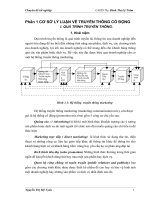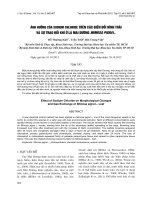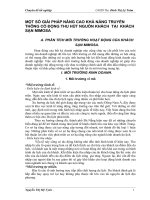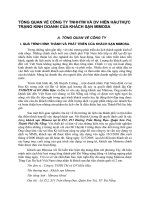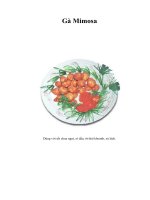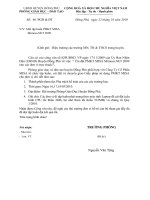Mimosa pudica
Bạn đang xem bản rút gọn của tài liệu. Xem và tải ngay bản đầy đủ của tài liệu tại đây (141.91 KB, 3 trang )
Mimosa pudica L. sensitive plant
FABACEAE
Synonyms: Mimosa tetrandra Humb. & Bonpl. ex Willd.
Mimosa pudica L. var. tetrandra (Willd.) DC.
Mimosa unijuga Duch. & Walp.
Mimosa pudica L. var. unijuga (Duch. & Walp.) Griseb.
General Description.—Sensitive plant is a small,
prostrate or ascending, short-lived shrub. Some
authors consider it a woody herb. It may reach 1 m
in height when supported on other vegetation and
more than 2 m in horizontal extension. The
reddish-brown, woody stems are sparsely or
densely armed with curved prickles. The root
system consists of a taproot and extensive fibrous
roots with nodules. The twigs are fine and flexible
and support leaves with one or two pairs of pinnae
and 15 to 25 pairs of oblong leaflets 3 to 12 mm
long. The flowers are pink and clustered in
globose heads. The legume (pod) is linear-oblong,
1.0 to 1.5 cm long and 3 mm broad, with bristles
on the margins. The pods are born in groups and
contain two to four brown seeds (Howard 1988,
Liogier 1988, Pacific Island Ecosystems at Risk
2001). Sensitive plant is also known as dorme
dorme, dormidera, humble plant, marie-honte,
mayhont, morivivi, honteuse, sleeping grass, ti
mawi, touch-me-not, and many other names (Holm
and others 1977, Howard 1988, Liogier 1988). The
great curiosity of sensitive plant and the source of
most of its names is that when touched, it quickly
folds its leaflets and pinnae and droops downward
at the petiole attachment. The leaves also droop at
night, and when exposed to rain or excessive heat.
This response may be defenses against herbivorous
insects, leaching loss of nutrients, or desiccation.
Range.—Sensitive plant was first described from
Brazil (Pacific Island Ecosystems at Risk 2001)
and is perhaps native to much or all of the New
World Tropics (Liogier 1988). Today, it is
pantropical in its distribution (Howard 1988).
Ecology.—Sensitive plant grows on most well-
drained soils, even scalped or eroded subsoils and
soils with low nutrient concentrations. It requires
disturbed soils to establish itself. Repeated burning
may encourage its spread in pastures (Siregar and
others 1990). Sensitive plant is shade intolerant
and does not compete with tall vegetation or grow
under forest canopies. The species’ roots produce
carbon disulfide, which selectively inhibits
colonization of the rhizosphere by mycorrhizal and
pathogenic fungi (Feng and others 1998). This
plant occurs in croplands, orchards, pastures,
mowed areas, roadsides, and areas disturbed by
construction. It may grow as a single plant or in
tangled thickets. Sensitive plant grows from near
sea level up to 1,300 m in elevation (Holm and
others 1977) and in areas with annual
precipitations from about 1000 to over 2000 mm.
The species is frost-sensitive.
Reproduction.—In the Philippines, sensitive plant
flowers all year and may produce as many as 675
seeds per plant per year (Holm and others 1977).
The species is both wind (Chieng and Huang
1998) and bee-pollinated (Payawal and others
1991). Air-dry seeds from Puerto Rico weighed an
average of 0.0065 +
0.0002 g/seed. With no
pretreatment, seeds from this collection began
germinating 7 days after sowing and reached a
maximum germination of 17 percent by 94 days
(author’s observation). In another test, 80 percent
germination was obtained in 4 weeks with
alternating temperatures of 20 and 40 °C (Holm
and others 1977). Bui (2001) recommends a
pretreatment with hot water followed by overnight
soaking. Germination is epigeal. Seeds are
transported by means of the bristles on the edges
of their pods that cling to clothing or to the fur of
mammals. Most nursery and home propagation is
done using seeds, but summer cuttings may also be
used (Bui 2001).
Growth and Management.—In Puerto Rico,
sensitive plants live 1 to 2 years. Seedlings grow
slowly for 2 or 3 months and then accelerate,
reaching 0.5 to 2 m of extension at the end of the
first year. Growth of plants that survive into the
second year is much slower. Potted and field-
grown individuals are sensitive to overwatering
(Bui 2001). This species has been successfully
tested and recommended for erosion control
plantings using potted material at a spacing of 60 x
60 cm (Coimbra and Magnanini 1953).
Benefits and Detriments.—Sensitive plant has
become a serious weed in fields of corn, soybeans,
tomatoes, upland rice, cotton, bananas, sugarcane,
coffee, oil palms, papayas, coconuts, and rubber in
many tropical areas. It is particularly troublesome
where hand pulling of weeds is practiced. The
species may be controlled by a number of
commercial broad-leaf herbicides (Bui 2001). On
the other hand, it is tolerated or valued as a forage
plant in pastures (Holm and others 1977, Turbet
and Thuraisingham 1948). In fact, sheep grazing
is reported to control sensitive plant in pastures
and plantations (Simonnet 1990). The root nodules
have been shown to fix nitrogen (Pokhriyal and
others 1990). Thickets of sensitive plant may be a
fire hazard when dry (Pacific Island Ecosystems at
Risk 2001). The seeds and other plant parts of
sensitive plant contain mimonsine, an amino acid
that is known to cause hair loss and depressed
growth in mammals (Arora 1983). An unlikely
large dose is necessary to cause problems,
however. The pollen is important to honeybees in
the Philippines (Payawal and others 1991).
Extracts of the plant have been shown in scientific
trials to be a moderate diuretic, depress duodenal
contractions similar to atropine sulphone, promote
regeneration of nerves, and reduce menorrhagia
(Modern-natural 2001). Anitdepressant activity
has been demonstrated in humans (Martínez and
others 1996). Root extracts are reported to be a
strong emetic (Guzmán 1975).
References
Arora, S.K., ed. 1983. Chemistry and biochemistry
of legumes. Edward Arnold (Publishers)
Limited, London. 358 p.
Bui, L-D. 2001. Mimosa pudica. http://bio.
maimi.edu/mimosa/mimosa.html. 7 p.
Chieng, H-T. and T.C. Huang. 1998. Aeropollen
of the Pingtung area, South Taiwan. Taiwania
43(2): 73-100.
Coimbra, A.F. and A. Magnanini. 1953.
Considerations sobre Mimosa pudica no
combate a arosao superficial. Anucio Brazilero
Economico da Floresta 6. Instituto Nacional,
Pinho, Brazil. 131-136.
Feng, Z., P.G. Hartel, R.W. Roncadori, S.J.S.
Sung, and J.E. Box. 1998. Inhibition of fungal
colonization on the rhizoplane of the CS2-
production plant, Mimosa pudica L. In: Plant
and Soil Sciences 82. Kluwer Academic
Publishers, Dordrecht, Netherlands. 115-126.
Guzmán, D.J. 1975. Especies utiles de la flora
salvadoreña. Ministerio de Educación, Dirección
de Publicaciones. San Salvador, El Salvador.
703 p.
Holm, L.G., D.L. Plucknett, J.V. Paucho, and J.P.
Herberger. 1977. The world’s worst weeds.
East-West Center, University of Hawaii,
Honolulu, HI. 609 p.
Howard R.A. 1988. Flora of the Lesser Antilles,
Leeward and Windward Islands.
Dicotyledoneae, Part 1. Vol. 4. Jamaica Plain,
MA: Arnold Arboretum, Harvard University.
673 p.
Liogier H.A. 1988. Descriptive flora of Puerto
Rico and adjacent islands, Spermatophyta. Vol.
2. Editorial de la Universidad de Puerto Rico,
Río Piedras, PR. 481 p.
Martínez R., G., F.F. Rodríguez L., C.M.
Contreras, and M. Molina H. 1996. Estudio
preliminary de las possibles acciones
antidepresivas de Mimosa pudica L. In:
Resumen de ponencias del Primer Congreso
Nacional de Plantas Medicinales de Mexico.
p. 69. July 24-30, 1996. Tlaxcala, Tlaxcala,
Mexico.
Modern-natural. 2001. Mimosa pudica Linn.
4 p.
Pacific Island Ecosystems at Risk. 2001. Invasive
plant species: Mimosa pudica Mart. ex Colla,
Fabaceae.
2 p.
Payawal, P.C., A.C. Tilde, and A.L. Manimtim.
1991. Year round pollen sources of Italian honey
bees (Apis mellifera L.) in the Philippines. III.
Selected areas. Philippine Agriculturist 74(4):
503-509.
Pokhriyal, T.C., H.C.S. Bhandari, D.S. Negi, S.P.
Chaukiyal, and B.B. Gupta. 1990. Identification
of some fast growing leguminous tree species
for nitrogen fixation studies. Indian Forester
116(6): 504-507.
Simonnet, P. 1990. Sheep flock management in a
tropical environment under coconut. Oleagineux
Paris 45(10): 451-456.
Siregar, M.E., B. Haryanto, and S. Tjitrosemito.
1990. A review of weed management in
Indonesian pastures. BIOTROP Special
Publication 38. A symposium on weed
mangement. 7-9 June 1989. Bogor, Indonesia. p.
229-235.
Turbet, C.R. and K. Thuraisingham. 1948. Feeding
trials with the sensitive plant Mimosa pudica.
Tropical Agriculturist, Ceylon 104(2): 81-86.
_________________________________________
John K. Francis, Research Forester, U.S.
Department of Agriculture, Forest Service,
International Institute of Tropical Forestry, Jardín
Botánico Sur, 1201 Calle Ceiba, San Juan PR
00926-1119, in cooperation with the University of
Puerto Rico, Río Piedras, PR 00936-4984
